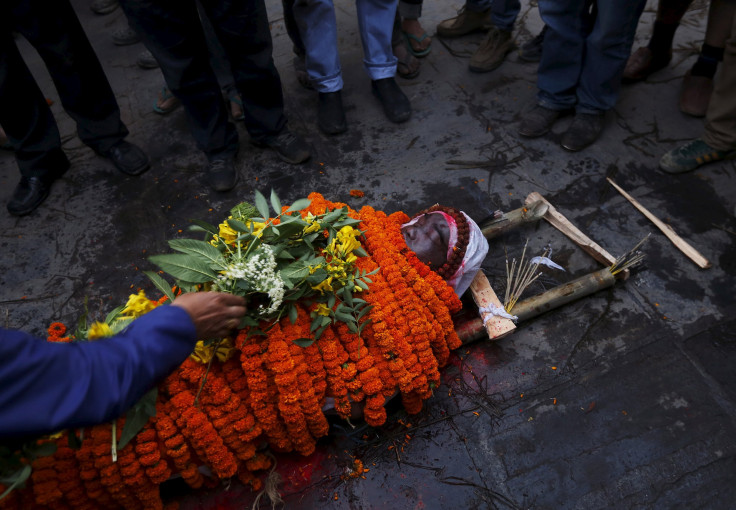Nepal Earthquake Aftermath: Government Calls For 3 Days Of Mourning As Country Struggles To Move Forward

Officials have confirmed the deaths of nearly 5,000 people from the Nepal earthquake; however, many expect that number to rise dramatically as searchers comb through cities and villages reduced to rubble. The government Tuesday declared three days of mourning for the victims of the quake.
"In memory of the Nepali and foreign brothers and sisters and elders and children who have lost their lives in this devastating earthquake, we have decided to observe three days of national mourning from today,” Prime Minister Sushil Koirala said in a televised address, according to the BBC.
Behind the official death toll numbers and rebuilding estimates are the stories of individuals whose lives were literally and figuratively upturned by a magnitude-7.8 earthquake that jolted the South Asian country Saturday. A worldwide humanitarian effort is underway to bring food, shelter and medicine to the survivors of the massive quake after their homes and villages crumbled.
Many in Nepal took to social media in the wake of the disaster to share stories of families torn apart by the quake. There also are accounts from people making the best of a terrible situation.
Juju Bhai was the only person in his family to survive the tremor after their house collapsed. Like many Nepali, Bhai did not have home insurance and now is living in a nearby shelter, the Nepali Times reported. He cremated his family Monday.
Individual tragedies like this make it a national tragedy. #NepalQuake http://t.co/zikqpE1I2E pic.twitter.com/PFz3HJHNd6
— Sonia Awale (@SoniaAwale) April 28, 2015A 6-year-old child was reportedly found alive underneath a massive collapsed bell in the Swayambhu area of Kathmandu, the capital of Nepal. A Nepalese journalist photographed the spot where the child was found.
6 year old was found alive beneath this bell. #Swayambhu #NepalQuake #NepalEarthquake pic.twitter.com/NIVrKc074r
— salokya (@salokya) April 28, 2015Search and rescue teams used sniffer dogs to look for victims trapped in the rubble in Kathmandu.
Rescuers are scouring the debris with sniffer dogs to locate those trapped under it. #NepalQuake #Nepal pic.twitter.com/MwYNSK6s8l
— The Kathmandu Post (@kathmandupost) April 28, 2015Then there are the stories of resilience in the face of great loss. Despite some rain, a couple married under a tent in Kathmandu just four days after the temblor brought the city to its knees.
#NepalQuake: Wedding ceremony while struggling to survive in open tents. Best wishes! pic Naveen Sth FB, @npniti pic.twitter.com/nJfe28OtgZ
— Gundruk Post (@GundrukPost) April 28, 2015Widespread power outages have meant many people are without electricity. Mobile phone users shared chargers in “harmony.”
1 charge station. 4 multi plugs. 30 mobile phones. 50 people. No jostling. That's what #Nepal is what about. Harmony. pic.twitter.com/XULPnaXzeI
— Prasanna KC (@KC_Prasanna) April 28, 2015Those left homeless sought shelter from aid groups. Officials were struggling to keep pace with demand. Residents fearing aftershocks have been sleeping in tents amid concerns buildings weakened by the earthquake would collapse.
i tried to buy tent bt no stock at Market. pls call me 9802011120 if anyone av . loc- Dhading Gajuri Ratmate. pic.twitter.com/GHD3EPHQRM
— Bhuwan Gurung (@bhuwa111) April 28, 2015Sunita Sitaula spent 33 hours beneath a fallen building in Kathmandu before rescuers were able to free her. She was reunited with her husband and two sons, and is now taking refuge at a school, local media reported.
Still alive: rescued from the rubble after 33 hours #NepalQuake http://t.co/OWgffW78MT pic.twitter.com/o850iefYjJ
— The Kathmandu Post (@kathmandupost) April 28, 2015© Copyright IBTimes 2024. All rights reserved.





















